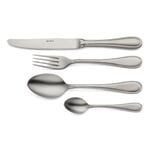Goyon-Chazeau table cutlery sandblasted

General Information
Discover singular products that may remind you of items you already know and appreciate; however, these products – exclusively available from us – feature a refined design meeting our clear-cut requirements.
New edition of almost forgotten forms
We have awakened this simple stainless steel cutlery series together with the knife manufacturer Goyon-Chazeau from a 30-year slumber. When the cutlery manufacturer Besset-Laroche, based near Thiers, was unable to find a successor in the 1980s, Coutellerie Goyon-Chazeau integrated the neighboring company into its own production without further ado - several tool molds and the expertise could be retained in this way. Our table cutlery, once designed by Besset-Laroche, was reworked over several months in close cooperation with Goyon-Chazeau - now the manufactory is relaunching the series and can even create another permanent job due to the additional production volume. In German-speaking countries, the cutlery series can only be found with us.
The lighter, the more artistic
What immediately strikes with this table cutlery is how light and balanced the knife is in the hand. If heavier table knives are otherwise increasingly in demand in Germany, this cutlery expresses a different concept of value. In traditional French table culture, the lighter the knife, the greater the craftsmanship. Following this claim, Goyon-Chazeau applies the rare monocoque process, in which the hollow handle of the knife is actually left hollow and elaborately welded to the sharp forged and hardened blade. The majority of hollow handled knives offered on the European market, on the other hand, are glued - the hollow handle is filled with putty for this purpose, and then the short tang of the blade is inserted into the still soft compound. In addition to weight and balance in the hand, welded table knives have two other decisive advantages over these puttied knives: First, the transition between blade and handle is completely sealed - so there is no danger of water getting inside when rinsing. Secondly, there is no putty material inside that could dissolve over time.
If only very few companies still make monocoque knives anyway, a quality such as we find at Goyon-Chazeau is even rarer. To weld the transition of blade and hilt so that it does not break is proof of high craftsmanship. During a visit to the Coutellerie, we were able to see for ourselves just how much expertise and precision is required to produce knives, forks and spoons of such quality. In the plant in La Monnerie-le-Montel, the majority of all manufacturing stages for our cutlery takes place, only a few steps such as forging the blades, rough grinding or deep drawing the forks and spoons are carried out in surrounding partner companies, because this requires special and very large machines.
Precision and experience - with more than 40 work steps
Our table knife goes through a total of more than 40 artisanal work steps. For the hilt, the cutlery makers at Goyon-Chazeau first shape the bowls using an imposing press: 150 tons of force press the stainless steel blanks into a hollow body, after which the metal protrusions around the bowls are punched out. The machine must be precisely adjusted to ensure that there are no defects in the edges, because a smooth edge is essential for joining the shells together. Two of them are placed on top of each other and spot-welded - so nothing can slip during circumferential welding. A gas-driven electrode passes around the edge and finally seals it completely. To avoid holes at the welds, Goyon-Chazeau uses a protective gas mixture of argon and CO₂ during this step. The craftsmen then grind the joined hollow handle smooth on a grindstone with ceramic grit, as this is the only way to ensure that the blade and handle, which are forged and hardened at a local partner company, are joined flush. Welding requires precision and experience; the cutlery makers need a good sense of how long to weld the two elements by hand. If a spot is heated too briefly, the parts will not hold together; if it takes too long, holes will appear at the bolster, the transition between the blade and the handle. As much as the employees strive here to make the individual pieces as similar as possible, the knives ultimately differ minimally because they are made by hand.
The final grind
The grinding and polishing process also requires craftsmanship; after all, the material must be removed as evenly as possible. For example, the craftsmen place the spaces between the forks around a machine-operated sanding belt before sharpening the fork tips on it and finishing the outer edges of the tines on diamond-coated sanding belts. In this way, each piece passes through numerous stations where the materials used on the rotating polishing wheels become finer and finer. Every fork, every spoon, every knife made by Goyon-Chazeau is finished until there are no more imperfections or scratches to be seen. In the case of the knives, the fine grinding and honing of the forged blades is then carried out - these, incidentally, come from a forge near Thiers, where other renowned companies from well-known knife cities such as Solingen also have their blanks manufactured.
For the sandblasted version of our tableware, an additional surface treatment is carried out with an air pressure gun after the finishing work. The small grains of sand leave a fine grain on the stainless steel. The process makes visible how well the cutlery makers have worked beforehand. Every little imperfection becomes visible, but the process also highlights the craftsmanship: for example, the bolster at the welding point does not become matte throughout, but remains shiny in places - a sign that two steels of different textures were joined at this point.
Finally, each piece goes through a precise quality control process. An employee carefully inspects each part. Finding it to be in good condition, she machine cleans the cutlery to completely remove the polish and test that the pieces are dishwasher safe. Finally, before leaving the premises after a final scrutinizing look, the individual pieces are marked with Goyon-Chazeau's signature.
Excellent Cutlery Production. Coutellerie Goyon-Chazeau.
Since 1953 you find the Coutellerie Goyon-Chazeau seven kilometres east of the French city of knives, Thiers in the Auvergne-Rhône-Alpes region. While there used to be numerous smithies in the region, which has been known for its cutlery for seven centuries, the knife manufacture in La Monnerie-le-Montel is now one of the few that still cultivates traditional craft techniques. True to their conviction, they produce completely locally. In 2013, the French state awarded the third-generation family business a label, the EPV (Entreprise du Patrimoine Vivant), for its commitment to preserving traditional craftsmanship in cutlery production.
Product Information
Article Number 16396
Made of 18/10 stainless steel, sandblasted. Made in France.
Knife: length 25 cm, handle length 11 cm, weight 72 g.
Fork: length 20 cm, length tines 5 cm, weight 58 g.
Spoon: length 20.5 cm, weight 72 g.
Coffee spoon: length 13.5 cm, weight 25 g.
Cake fork: length 14 cm. Length of tines 3 cm. Weight 22 g.
If you have a question concerning this product you are welcome to contact us. For this your E-Mail program will open.
Customer Service
Ob Beratung, Ersatzteile oder Sonderwünsche - all Ihre Fragen und Anliegen behandelt unser Customer Service persönlich und fundiert.
Sie erreichen uns von Montag bis Freitag unter der Nummer +49 2309 939095 oder jederzeit unter info@manufactum.de
Exklusiv bei Manufactum
Wir bieten Ihnen eine Reihe ganz besonderer Produkte von ausgewählten Herstellern, die in dieser Form nur bei Manufactum erhältlich sind und bei denen wir Ihnen ein Höchstmaß an Materialität und Funktionalität garantieren können.
Alle Exklusiv-Produkte


